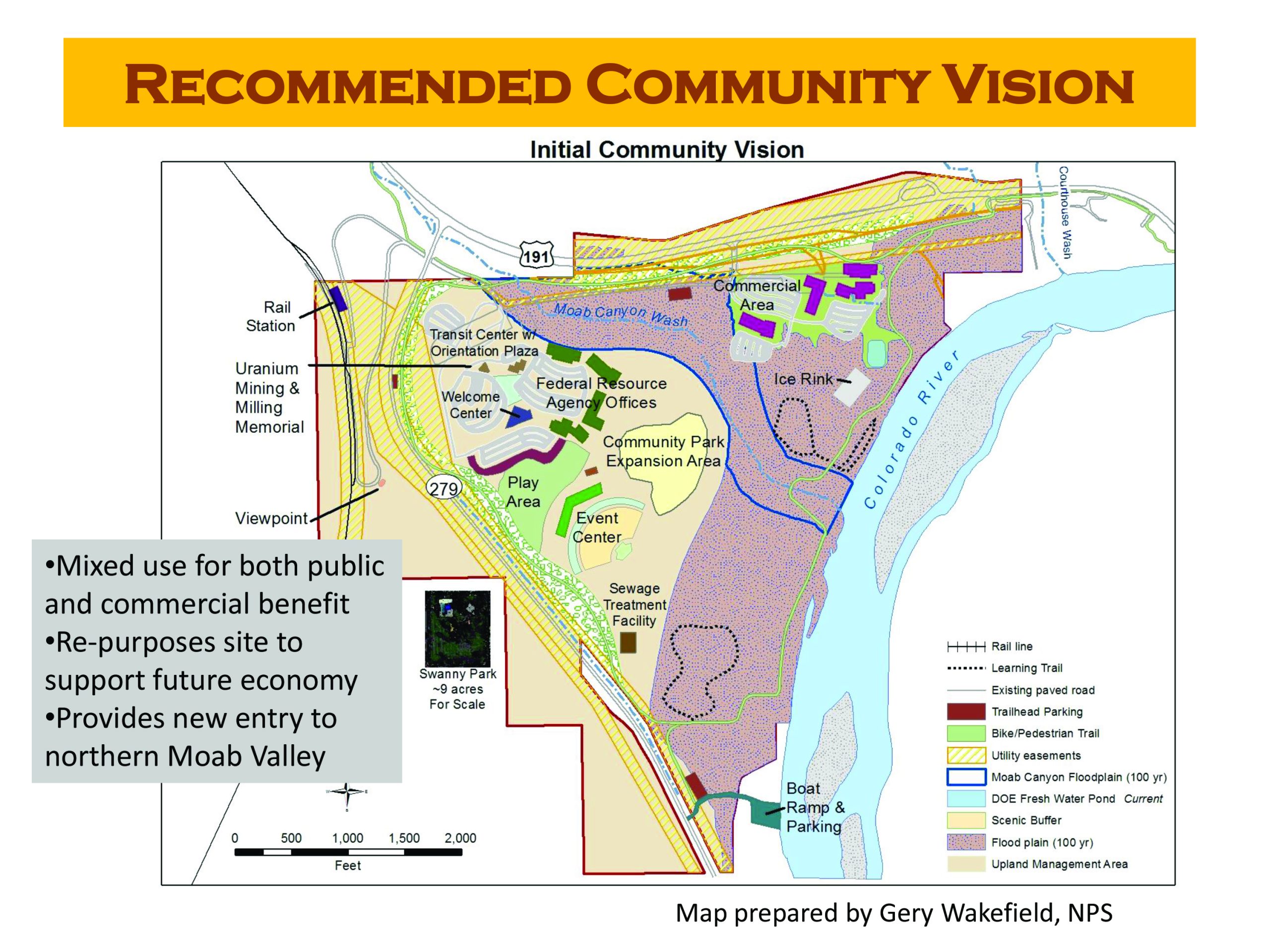Some information may be outdated.
The Moab Tailings Project Steering Committee accepted the Community Vision plan presented by the Site Futures Committee at their meeting Wednesday, Nov. 13.
The Community Vision plan was one of four plans that was drafted by the Site Futures Committee after receiving public input since May.
The Department of Energy (DOE) now owns the 474-acre Uranium Mill Tailings Remediation Action (UMTRA) site north of Moab that was used as an uranium mill and tailings pond between 1956 and 1984.
In 2009 the DOE began the removal of 16 million tons of tailings from the site to a permanent disposal site 30 miles north of Moab near Crescent Junction. A third of the tailings have already been moved. It is projected that the removal of the tailings will not be completed until 2025 or 2029, depending on the level of federal funding for the remediation.
The Site Futures Committee began seeking public input in May for how the site should be used after the clean-up is completed. Over several months, the committee took those suggestions to draft a vision to be presented to the Moab Tailings Project Steering Committee.
One resounding theme presented in all the proposed site plans was that it should be a community asset and provide an appealing gateway to Moab.
There are limitations to developing the property.
Although the entire site is 474 acres, due to 171 acres of floodplain from the Moab Canyon Wash and Colorado River, 104 acres of soil contamination, 102 acres of easements, and 29 acres of steep slopes – there may be less than 100 acres of viable land.
Rock Smith, one of the members of the Site Futures Committee, said that certain elements were included in all four plans to be considered: a rail station, a transit center, and bike and pedestrian trails. Because city sewer services are not available on the north side of the Colorado River, it is also advised for the property to have its own wastewater treatment site.
These elements were used in the four different plans considered: Restoration and Trails, Community Park, Commercial Use and Community Vision. These four plans were created based on input given at the May open house meeting. These plans were presented to the public for further comment in September.
“It was recommended to do the ‘Community Vision’ plan,” Smith said.
The Community Vision plan includes the elements in the Common to All, such as the rail station, transit center and trails. The Community Vision plan also incorporated several elements from the three other plans: Restoration and Trails, Community Park and Commercial Use. It may also include a community park play area, a commercial area, federal offices, an ice rink and an event center.
“This is to be a community asset, an appealing gateway to Moab,” Smith said. “This is what the public said they most currently want. By 2025, the vision may change. We’ll be revisiting this several times between now and then.”
Smith referred to the conceptual drawing as a “glorified bubble drawing.”
“It may not have all these facilities, but this is an idea of where it would be,” Smith said. “Mixed use for public benefit.”
While the public expressed a desire for the site to use alternate energy sources, they didn’t want to see the site as an energy farm.
“People weren’t interested in a solar farm,” Smith said. “They wanted to see the solar incorporated into the structures themselves.”
Lee Shenton, the site liaison between Grand County and the DOE, said the endorsement is a starting point for future plannning.
Between 2014 and 2025 the vision should be updated, he said, by using additional public and agency input and to continue to foster community discussion on potential site management.
Before 2025, when the remediation at the site should be completed as per current funding for the clean-up, a site transition plan could be drafted.
“If DOE is amenable to site transfer, we would then proceed with a management plan of North Moab Valley Gateway Area,” Shenton said.
Marian DeLay, one of the steering committee members, commended Smith for a clear and concise presentation.
“Thank you to the Site Futures Committee. You took on a major task,” DeLay said. “This is so far in the future; I hope I’m around.”
The plan will be presented to the Moab City and Grand County councils at a joint meeting 11:30 a.m., Nov. 21. Both councils can choose whether to endorse the plans at separate council meetings later.
Appreciate the coverage? Help keep local news alive.
Chip in to support the Moab Sun News.





